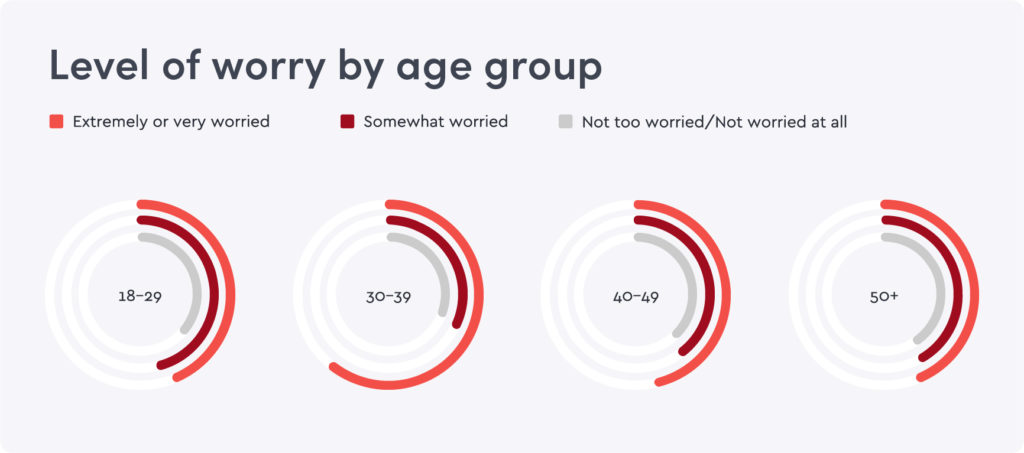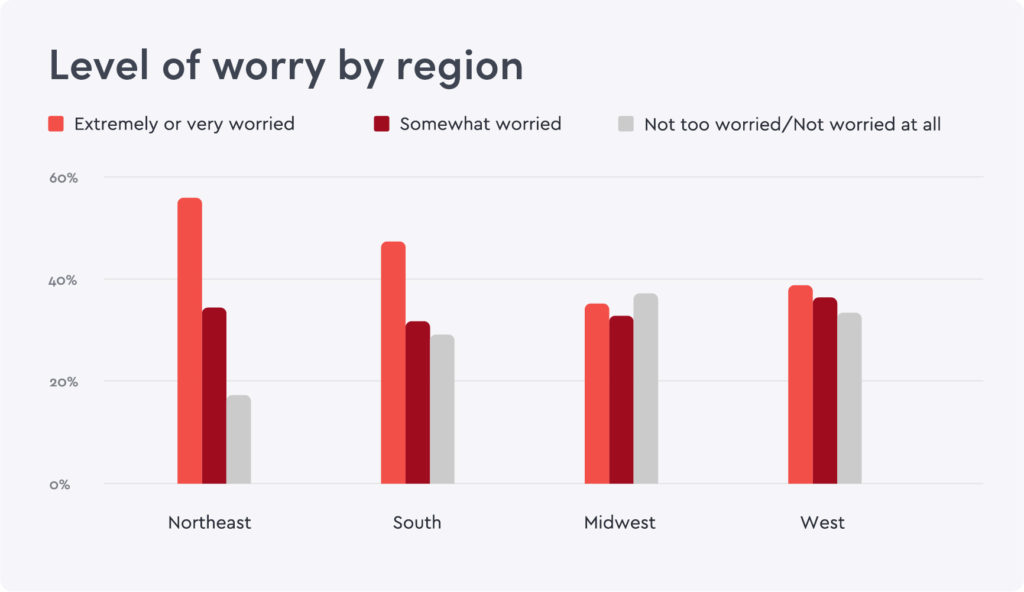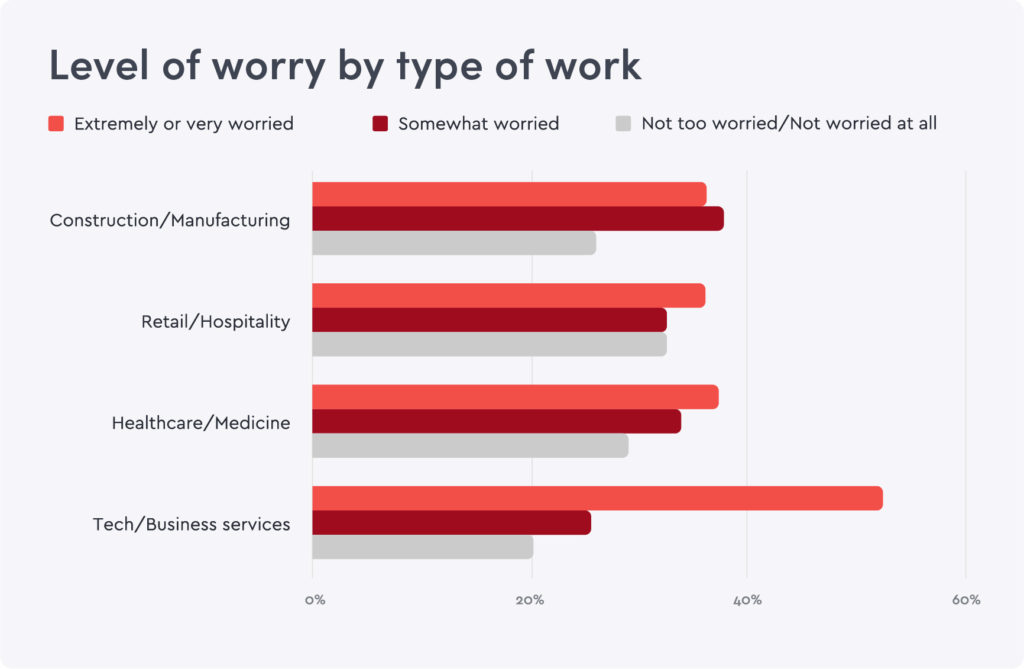Whether your workplace never closed or reopens soon, you’ve sensed that employees worry about going to work each day. And your sense would be right: an Envoy survey of 1,000 US workers found that 73% now worry about their health and safety at work. This shouldn’t be a surprise—it’s the middle of a pandemic! Plus, COVID-19 spreads when people come near each other indoors. Most people can see the writing’s on the wall.
Despite an overall feeling of worry, the data shows some demographics worry more than others. A person’s age, location, type of work, and company size influence their level of concern about heading back to their office or job site.
As a workplace or HR leader, you can help employees feel more comfortable coming back by first understanding who’s concerned. Below, we highlight how different groups answered the question, “How worried for your health and safety are you with regard to going into the workplace?” Use these insights and others from our latest report to learn how you can help employees feel safe and focus on the work that matters.
Thirty-somethings worry more than their older counterparts
Contrary to popular belief, it’s not older folks but people in their thirties that express the most significant concern about returning to work. People over fifty were most likely, of all the groups, to say they weren’t worried at all.

It’s difficult to know why thirty-somethings are so worried, but it may relate to who’s at home waiting for them to return: their kids. People in their thirties are most likely to be parents of young kids, which may be the source of their heightened unease. They may fear bringing the virus home to their children. With many schools relying on distance learning from home, and daycares closed due to the pandemic, they’re likely anxious about arranging for childcare in their absence. One of the best ways to support parents and their children is by being flexible and offering a hybrid working environment. That could mean letting employees work from home more often or moving conference calls to more convenient times. Another way to ensure parents have enough headspace to focus on their work is by providing a stipend for childcare costs. Companies that subsidize childcare can get a tax break from the federal government for up to 25 percent of the cost.
People from the northeast and south aren’t as keen to return
As COVID-19 outbreaks move from one region of the US, the people in those areas grow more concerned about being in the office.We asked people about their concerns in August 2020, not long after the northeast and south saw COVID-19 outbreaks. It’s likely no coincidence that people in the northeast and the south currently worry most about being in close contact with others at work. In contrast to other parts of the country, people in the northeast and south more likely understand the dangers of COVID-19.

If you have employees in these regions, keep in mind that they may need more reassurance before they return to the workplace. Be transparent and share detailed information about your reopening plans to put people at ease. Consider catering your phased reopening plans to each region, and make that clear to employees. For instance, folks in New York City or New Orleans may hope to see stricter protocols or city-specific accommodations. The more your employees can see that you’re taking all the necessary precautions, the safer they will feel coming to work.
Knowledge workers worry more than essential workers
Different jobs require different levels of physical contact with other people. So it’s no surprise that the type of work someone does influences how they feel about being back on-site.You would think that people in essential jobs would be most concerned about their safety. But the results show just the opposite. People who work in technology and business jobs, which can likely be done from home, are most concerned about returning. People who work in retail stores, assembly lines, and hospitals, on the other hand, didn’t express the same level of anxiety.

Because people in tech or business services are least likely to be back in the office, their anxieties may arise from a fear of the unknown. These jobs also tend to center in cities, where illnesses spread faster. If you’re a technology company or in business services, survey your employees to understand what concerns them most about returning. If a top concern is taking public transportation, for example, consider providing a parking or biking stipend.
Employees of small businesses are more concerned that those at big companies
Last, people’s concerns about returning to their workplace waver depending on the size of the company they work for. Smaller companies tend to have fewer resources and perks than their larger counterparts. People who work at companies with fewer than 250 employees may perceive that their employer doesn’t have the means to adequately protect their health and safety.Small companies are known for being scrappy and hustling to make ends meet. But when it comes to employees’ safety and health, they want reassurance that their employer will take all necessary steps to keep them safe.

Thermal cameras, density counters, and contact tracing beacons don’t hurt, but they can put you back tens of thousands of dollars each month. Thankfully, companies don’t need to break their budget to protect employees. Simply providing masks and asking employees to complete a health check can make a big difference. If you do choose to use technology to manage your return, look for an all-in-one return-to-work solution. Not only will you save money by buying from one provider instead of many, but you will also save time rolling it out and managing it in the long run.
Want more insight into people’s concerns about returning to workplaces? See these findings and more in our report: How to Make Employees Feel Safe at Work During COVID-19.
Read more
Searching for a visitor management solution? Learn what to look out for and how to choose the best tech for your team.
Managing your space well doesn’t have to be difficult. But if you want to be successful, you need the right approach.
A well-run workplace can set your team up for success. Learn why workplace management matters and how to do it right.
Workplace security is critical to the future of your business. Learn why it matters, what threats to watch for, and how to strengthen your workplace security plan.
In this post, we’ll explore what workplace compliance is and how to build a compliance culture for your organization.
With more folks sending personal packages to the workplace, having a sound mailroom management system in place is key.










